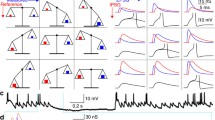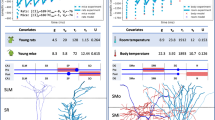Abstract
Linear additivity of synaptic input is a pervasive assumption in computational neuroscience, and previously Bernander et al. (Journal of Neurophysiology 72:2743–2753, 1994) point out that the sublinear additivity of a passive neuronal model can be linearized with voltage-dependent currents. Here we re-examine this perspective in light of more recent findings and issues. Based on in vivo intracellular recordings, three voltage-dependent conductances seem to be of interest for pyramidal cells of the forebrain: two of them are amplifying, I NaP and I h ; and one of them is attenuating, I A . Based on particular I-V characteristics reported in the literature, each of these three voltage-dependent currents linearizes a particular range of synaptic excitation. Computational simulations use a steady-state, one-compartment model. They establish maximal linear ranges, where supralinear effects—due to adding too much of any one conductance—limit these ranges. Specific, carefully selected pairwise combinations of these currents can linearize larger ranges than either current alone. In terms of parameters, the steady-state I-V characteristics of each current are critical. On the other hand, the relationships between the results here and resting conductance to ground, synaptic conductance, and number of active synapses are simple and easily scaled; thus in regard to these three latter dependences, the results here are easily generalized. Finally, to improve our understanding of evolved function, the relative metabolic costs of linearization are quantified. In one case, there is a clear preference arising from this cost consideration (a particular I h , I NaP pairing is less costly compared to a particular I A , I NaP pairing that produces an equivalent, linearized range). However in other cases, a preference will depend on the required range; but in any event, the largest linearized range observed here (28 mV), from a combination of I h and I A , is significantly more costly than the 20 mV range that the I h , I NaP pair produces.








Similar content being viewed by others
References
Agrawal, N., Hamam, B. N., Magistretti, J., Alonso, A., & Ragsdale, D. S. (2001). Persistent sodium channel activity mediates subthreshold membrane potential oscillations and low-threshold spikes in rat entorhinal cortex layer v neurons. Neuroscience, 102, 53–64. doi:10.1016/S0306-4522(00)00455-3.
Andrasfalvy, B. K., & Magee, J. C. (2001). Distance-dependent increase in AMPA receptor number in the dendrites of adult hippocampal CA1 pyramidal neurons. The Journal of Neuroscience, 21, 9151–9159.
Attwell, D., & Gibb, A. (2005). Neuroenergetics and the kinetic design of excitatory synapses. Nature Reviews. Neuroscience, 11, 841–849. doi:10.1038/nrn1784.
Attwell, D., & Laughlin, S. B. (2001). An energy budget for signalling in the grey matter of the brain. Journal of Cerebral Blood Flow and Metabolism, 21, 1133–1145. doi:10.1097/00004647-200110000-00001.
Balasubramanian, V., & Berry II, M. J. (2002). A test of metabolically efficient coding in the retina. Network, 13, 531–552.
Bekkers, J. M. (2000). Distribution and activation of voltage-gated potassium channels in cell-attached and outside-out patches from large layer 5 cortical pyramidal neurons of the rat. The Journal of Physiology, 525, 611–620. doi:10.1111/j.1469-7793.2000.t01-2-00611.x.
Bernander, O., Koch, C., & Douglas, R. J. (1994). Amplification and linearization of distal synaptic input to cortical pyramidal cells. Journal of Neurophysiology, 72, 2743–2753.
Bernardo, J. M., & Smith, A. F. M. (2000). Bayesian theory. New York: Wiley 608 pp.
Carandini, M., Heeger, D. J., & Movshon, J. A. (1997). Linearity and normalization in simple cells of the macaque primary visual cortex. The Journal of Neuroscience, 17, 8621–8644.
Cash, S., & Yuste, R. (1999). Linear summation of excitatory inputs by CA1 pyramidal neurons. Neuron, 22, 383–394. doi:10.1016/S0896-6273(00)81098-3.
Colbert, C. M., & Johnston, D. (1996). Axonal action-potential initiation and Na+ channel densities in the soma and axon initial segment of subicular pyramidal neurons. The Journal of Neuroscience, 16, 6676–6686.
Cook, E. P., Wilhelm, A. C., Guest, J. A., Lian, Y., Masse, N. Y., & Colbert, C. M. (2007). The neuronal transfer function: contributions from voltage- and time-dependent mechanisms. Progress in Brain Research, 165, 1–11. doi:10.1016/S0079-6123(06)65001-2.
Crochet, S., & Petersen, C. C. H. (2006). Correlating whisker behavior with membrane potential in barrel cortex of awake mice. Nature Neuroscience, 9, 608–610. doi:10.1038/nn1690.
DeAngelis, G. C., Ohzawa, I., & Freeman, R. D. (1993). Spatiotemporal organization of simple-cell receptive fields in the cat’s striate cortex. II. Linearity of temporal and spatial summation. Journal of Neurophysiology, 69, 1118–1135.
Destexhe, A., Rudolph, M., & Pare, D. (2003). The high-conductance state of neocortical neurons in vivo. Nature Reviews. Neuroscience, 4, 739–751. doi:10.1038/nrn1198.
Fee, M. S. (2000). Active stabilization of electrodes for intracellular recording in awake behaving animals. Neuron, 27, 461–468. doi:10.1016/S0896-6273(00)00057-X.
Ferster, D. (1994). Linearity of synaptic interactions in the assembly of receptive fields in cat visual cortex. Current Opinion in Neurobiology, 4, 563–568. doi:10.1016/0959-4388(94)90058-2.
French, C. R., Sah, P., Buckett, K. J., & Gage, P. W. (1990). A voltage-dependent persistent sodium current in mammalian hippocampal neurons. The Journal of General Physiology, 95, 1139–1157. doi:10.1085/jgp.95.6.1139.
Gasparini, S., & Magee, J. C. (2006). State-dependent dendritic computation in hippocampal ca1 pyramidal neurons. The Journal of Neuroscience, 26, 2088–2100. doi:10.1523/JNEUROSCI.4428-05.2006.
Goldberg, D. H., Sripati, A. P., & Andreou, A. G. (2003). Energy efficiency in a channel model for the spiking axon. Neurocomputing 52–54. Computational Neuroscience: Trends in Research, 2003, 39–44.
Goldman, D. E. (1943). Potential, impedance and rectification in membranes. The Journal of General Physiology, 27, 37–60. doi:10.1085/jgp.27.1.37.
Gulledge, A. T., Kampa, B. M., & Stuart, G. J. (2005). Synaptic integration in dendritic trees. Journal of Neurobiology, 64, 75–90. doi:10.1002/neu.20144.
Hasenstaub, A., Shu, Y., Haider, B., Kraushaar, U., Duque, A., & McCormick, D. A. (2005). Inhibitory postsynaptic potentials carry synchronized frequency information in active cortical networks. Neuron, 47, 423–435. doi:10.1016/j.neuron.2005.06.016.
Hodgkin, A. L., & Huxley, A. F. (1952). A quantitative description of membrane current and its application to conduction and excitation in nerve. The Journal of Physiology, 117, 500–544.
Hodgkin, A. L., & Katz, B. (1949). The effect of sodium ions on the electrical activity of the giant axon of the squid. The Journal of Physiology, 108, 37–77.
Hoffman, D. A., Magee, J. C., Colbert, C. M., & Johnston, D. (1997). K+ channel regulation of signal propagation in dendrites of hippocampal pyramidal neurons. Nature, 387, 869–875. doi:10.1038/42571.
Jagadeesh, B., Wheat, H. S., & Ferster, D. (1993). Linearity of summation of synaptic potentials underlying direction selectivity in simple cells of the cat visual cortex. Science, 262, 1901–1904. doi:10.1126/science.8266083.
Johnston, D., Magee, J. C., Colbert, C. M., & Christie, B. R. (1996). Active properties of neuronal dendrites. Annual Review of Neuroscience, 19, 165–186. doi:10.1146/annurev.ne.19.030196.001121.
Laughlin, S. B., & Sejnowski, T. J. (2003). Communication in neural networks. Science, 301, 1870–1874. doi:10.1126/science.1089662.
Léger, J.-F., Stern, E. A., Aertsen, A., & Heck, D. (2005). Synaptic integration in rat frontal cortex shaped by network activity. Journal of Neurophysiology, 93, 281–293. doi:10.1152/jn.00067.2003.
Levy, W. B., & Baxter, R. A. (1996). Energy efficient neural codes. Neural Computation, 8, 531–543. doi:10.1162/neco.1996.8.3.531.
Levy, W. B., & Baxter, R. A. (2002). Energy-efficient neuronal computation via quantal synaptic failures. The Journal of Neuroscience, 22, 4746–4755.
Levy, W. B with simulations by Morel, D. (2006). A Bayesian Constraint on Neural Computation. Proceeding of the IEEE, International Symposium on Information Theory (ISIT), Seattle, Washington, July 9–14.
Levy, W. B., Colbert, C. M., & Desmond, N. L. (1990). Elemental adaptive processes of neurons and synapses: a statistical/computational perspective. In M. Gluck & D. Rumelhart (Ed.) Neuroscience and Connectionist Theory (pp. 187–253). Lawrence Erlbaum Associates.
London, M., & Häusser, M. (2005). Dendritic computation. Annual Review of Neuroscience, 28, 503–532.
Magee, J. C. (1998). Dendritic hyperpolarization-activated currents modify the integrative properties of hippocampal CA1 pyramidal neurons. The Journal of Neuroscience, 18(19), 7613–7624.
Magee, J. C. (1999). Voltage-gated ion channels in dendrites. In G. Stuart, N. Spruston, & M. Häusser (Eds.), Dendrites (pp. 139–160). Oxford University Press.
Magee, J. C. (2000). Dendritic integration of excitatory synaptic input. Nature Reviews. Neuroscience, 1, 181–190. doi:10.1038/35044552.
Magee, J. C., & Cook, E. P. (2000). Somatic EPSP amplitude of synapse location in hippocampal pyramidal neurons. Nature Neuroscience, 3, 895–903. doi:10.1038/78800.
Magee, J. C., Hoffman, D., Colbert, C., & Johnston, D. (1998). Electrical and calcium signaling in dendrites of hippocampal pyramidal neurons. Annual Review of Physiology, 60, 327–346. doi:10.1146/annurev.physiol.60.1.327.
Magistretti, J., & Alonso, A. (1999). Biophysical properties and slow voltage-dependent inactivation of a sustained sodium current in entorhinal cortex layer-II principal neurons. The Journal of General Physiology, 114, 491–509. doi:10.1085/jgp.114.4.491.
McCulloch, W. S., & Pitts, W. H. (1943). A logical calculus of the ideas immanent in nervous activity. The Bulletin of Mathematical Biophysics, 5, 115–133. doi:10.1007/BF02478259.
Morel, D., & Levy, W. B. (2007). Persistent sodium is a better linearizing mechanism than the hyperpolarization-activated current. Neurocomputing, 70, 1635–1639. doi:10.1016/j.neucom.2006.10.054.
Paré, D., Shink, E., Gaudreau, H., Destexhe, A., & Lang, E. J. (1998). Impact of spontaneous synaptic activity on the resting properties of cat neocortical pyramidal neurons in vivo. Journal of Neurophysiology, 79, 1450–1460.
Polsky, A., Mel, B. W., & Schiller, J. (2004). Computational subunits in thin dendrites of pyramidal cells. Nature Neuroscience, 7, 621–627. doi:10.1038/nn1253.
Priebe, J., & Ferster, D. (2005). Direction selectivity of excitation and inhibition in simple cells of the cat primary visual cortex. Neuron, 45, 133–145. doi:10.1016/j.neuron.2004.12.024.
Sarpeshkar, R. (1998). Analog versus digital: extrapolating from electronics to neurobiology. Neural Computation, 10, 1601–1638. doi:10.1162/089976698300017052.
Spruston, N., Jonas, P., & Sakmann, B. (1995). Dendritic glutamate receptor channels in rat hippocampal CA3 and CA1 pyramidal neurons. The Journal of Physiology, 482, 325–352.
Steriade, M., Timofeev, I., & Grenier, F. (2001). Natural waking and sleep states: a view from inside neocortical neurons. Journal of Neurophysiology, 85, 1969–1985.
Vervaeke, K., Hu, H., Graham, L. J., & Storm, J. F. (2006). Contrasting effects of the persistent Na+ current on neuronal excitability and spike timing. Neuron, 49, 257–270. doi:10.1016/j.neuron.2005.12.022.
Vincent, T. V., & Baddeley, R. J. (2003). Synaptic energy efficiency in retinal processing. Vision Research, 43, 1283–1290. doi:10.1016/S0042-6989(03)00096-8.
Vincent, T. V., Baddeley, R. J., Troscianko, T., & Gilchrist, I. D. (2005). Is the early visual system optimized to be energy efficient? Network, 16, 175–190.
Yuste, R., & Tank, D. W. (1996). Dendritic integration in mammalian neurons a century after Cajal. Neuron, 16, 701–716. doi:10.1016/S0896-6273(00)80091-4.
Acknowledgements
The authors would like to thank the Walter and Mary Munster Foundation for their support.
Author information
Authors and Affiliations
Corresponding author
Additional information
Action Editor: Erik De Schutter
Appendices
Appendix A
The relationships of Table 5 are made more transparent by a few equations. Using the NaP-enhanced system as an example, the basic current equations (d = dendrite, s = synapses, and NaP = persistent sodium) and their derivatives are
Remembering that, in steady-state, the sum of the currents is zero (i.e., I s + I NaP + I d = 0), the derivatives can also be combined and \(\frac{{df\left( {V_{\text{m}} } \right)}}{{dV_{\text{m}} }}\) solved for such that
Let V s = 0 and, in the linear range, let \(\frac{{dV_{m} {\left( {g_{s} } \right)}}}{{dg_{s} }}\) = constant = K. Rearranging Eq. (9) gives
Taking the derivative with respect to V m of both sides of this equation sets up the ordinary differential equation
which can be solved for f(V m ). That is,
where C 1 and C 2 are constants. Finally, Eq. (10) and its derivative df(V m )/dV m can be substituted back into Eq. (9) which can then be solved for V m in the linear range.
where C 2 is a constant whose value is independent of g s and V m . The last equation shows that, in the linear range, since V m changes linearly with g s , the numerator is a linear function of g s . This implies that the denominator also changes linearly (i.e., if g s is doubled so must g d and \(\overline{g} _{{NaP}} \)) to maintain dV m (g s )/dg s = constant. The inverse relationship between dV m (g s )/dg s and g d or g s or \(\overline{g} _{{NaP}} \) is also apparent in the last equation. Equivalent equations can be derived for a system which includes I A .
Appendix B
Rights and permissions
About this article
Cite this article
Morel, D., B Levy, W. The cost of linearization. J Comput Neurosci 27, 259–275 (2009). https://doi.org/10.1007/s10827-009-0141-y
Received:
Revised:
Accepted:
Published:
Issue Date:
DOI: https://doi.org/10.1007/s10827-009-0141-y




